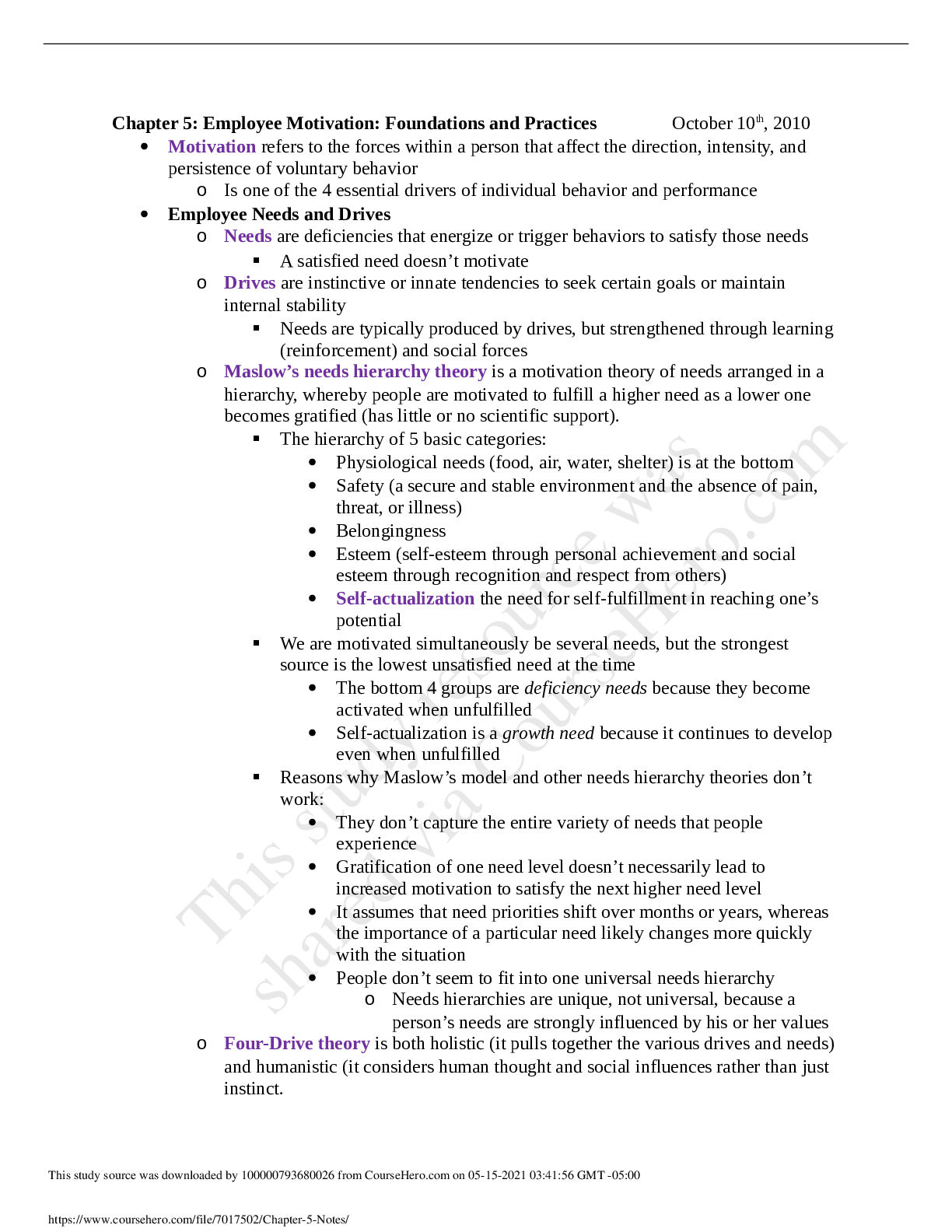
Solution Manual Linear Algebra and its Applications 3rd Edition
$ 17

Certified Professional Coding Test 2022 COMPLETE SOLUTIONS
Business > Class Notes > Chapter 5: Employee Motivation: Foundations and Practices(latest update) (All)
Chapter 5: Employee Motivation: Foundations and Practices October 10th, 2010 • Motivation refers to the forces within a person that affect the direction, intensity, and persistence of voluntary be ... havior o Is one of the 4 essential drivers of individual behavior and performance • Employee Needs and Drives o Needs are deficiencies that energize or trigger behaviors to satisfy those needs A satisfied need doesn’t motivate o Drives are instinctive or innate tendencies to seek certain goals or maintain internal stability Needs are typically produced by drives, but strengthened through learning (reinforcement) and social forces o Maslow’s needs hierarchy theory is a motivation theory of needs arranged in a hierarchy, whereby people are motivated to fulfill a higher need as a lower one becomes gratified (has little or no scientific support). The hierarchy of 5 basic categories: • Physiological needs (food, air, water, shelter) is at the bottom • Safety (a secure and stable environment and the absence of pain, threat, or illness) • Belongingness • Esteem (self-esteem through personal achievement and social esteem through recognition and respect from others) • Self-actualization the need for self-fulfillment in reaching one’s potential We are motivated simultaneously be several needs, but the strongest source is the lowest unsatisfied need at the time • The bottom 4 groups are deficiency needs because they become activated when unfulfilled • Self-actualization is a growth need because it continues to develop even when unfulfilled Reasons why Maslow’s model and other needs hierarchy theories don’t work: • They don’t capture the entire variety of needs that people experience • Gratification of one need level doesn’t necessarily lead to increased motivation to satisfy the next higher need level • It assumes that need priorities shift over months or years, whereas the importance of a particular need likely changes more quickly with the situation • People don’t seem to fit into one universal needs hierarchy o Needs hierarchies are unique, not universal, because a person’s needs are strongly influenced by his or her values o Four-Drive theory is both holistic (it pulls together the various drives and needs) and humanistic (it considers human thought and social influences rather than just instinct. According to four-drive theory, everyone has the: • Drive to acquire: the drive to seek, take, control, and retain objects and personal experiences o Is the foundation of competition and the basis of our need for esteem • Drive to bond: the drive to form social relationships and develop mutual caring commitments with others o Motivates people to cooperate • Drive to learn: the drive to satisfy our curiosity, to know and understand ourselves and the environment around us • Drive to defend: includes defending our relationships, our acquisitions, and our belief systems o The drive to defend is always reactive – is triggered by threat o The other 3 are always proactive – we actively seek to improve our acquisitions, relationships, and knowledge All four drives are innate, universal, and independent of each other o Recall: every meaningful bit of information we receive is quickly and unconsciously tagged with emotional markers that swirl around our conscious process of logically analyzing that information - Our motivation to act is therefore a result of rational thinking influenced by these emotional markers The four drives determine which emotional markers, if any, are attached to the perceived information Four-drive theory further explains that the process is conscious (humanistic) rather than instinctive, because these drives produce independent and often competing signals that require our attention Our conscious analysis of competing demands from the four drives generates needs that energize us to act in ways acceptable to society and our own moral compass o The main implication of four-drive theory is that companies need to ensure that individual jobs and workplaces provide a balanced opportunity to [Show More]
Last updated: 3 years ago
Preview 1 out of 8 pages

Buy this document to get the full access instantly
Instant Download Access after purchase
Buy NowInstant download
We Accept:

Can't find what you want? Try our AI powered Search
Connected school, study & course
About the document
Uploaded On
May 15, 2021
Number of pages
8
Written in
All
This document has been written for:
Uploaded
May 15, 2021
Downloads
0
Views
185
Scholarfriends.com Online Platform by Browsegrades Inc. 651N South Broad St, Middletown DE. United States.
We're available through e-mail, Twitter, Facebook, and live chat.
FAQ
Questions? Leave a message!
Copyright © Scholarfriends · High quality services·